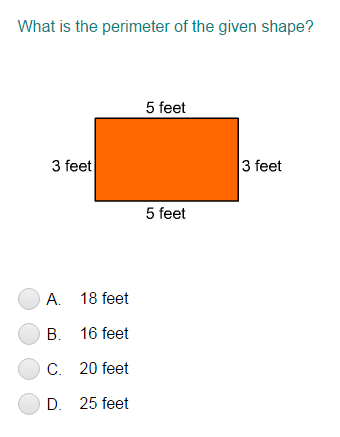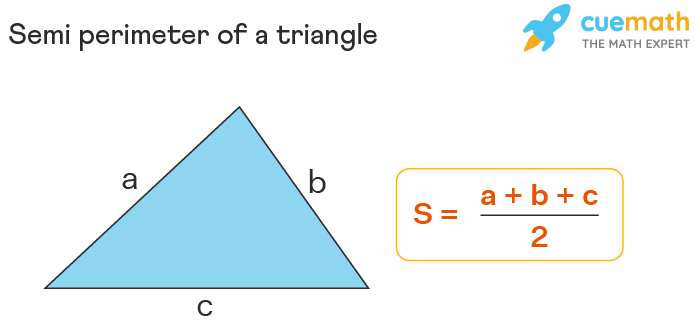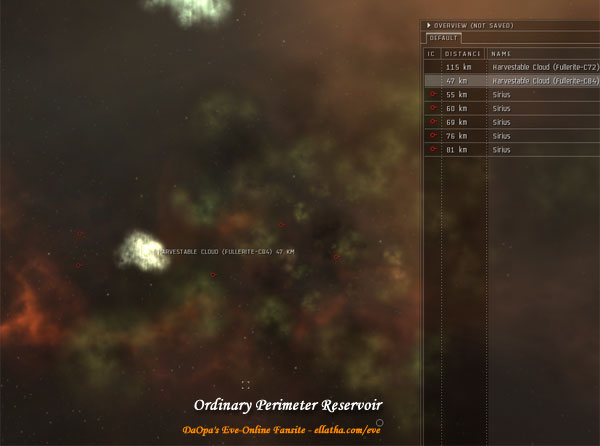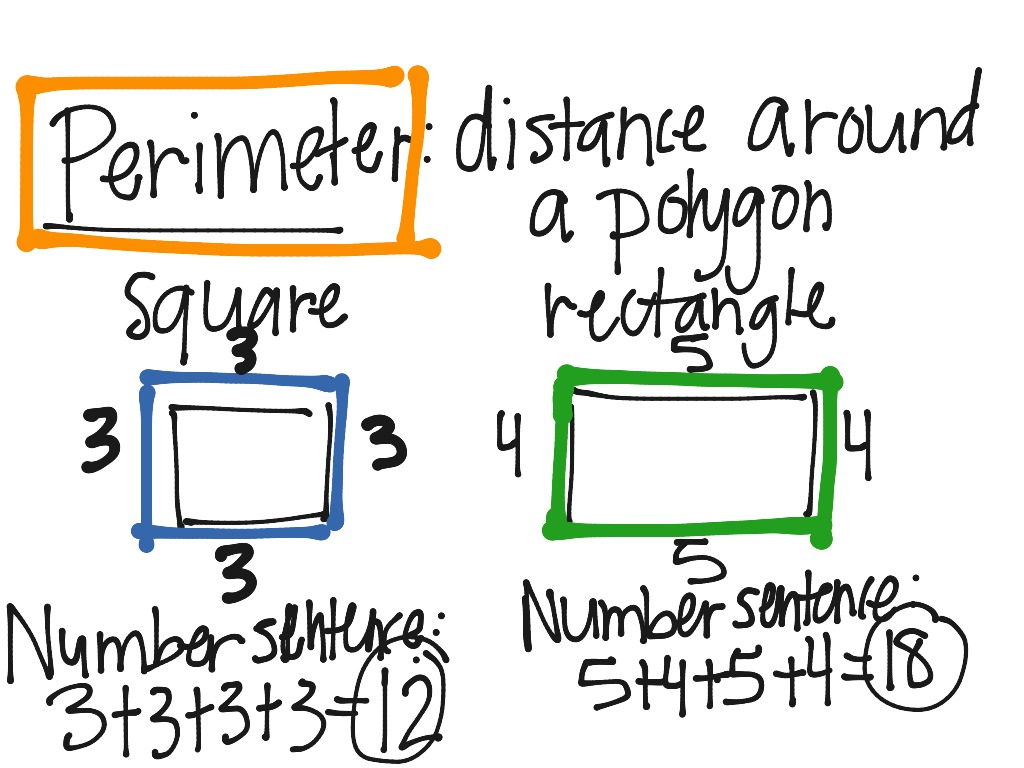Topic perimeter is measured in: The perimeter of a shape is measured in linear units and is essential for a variety of practical applications, from construction to design. This guide explores how perimeter is measured, its formulas for different shapes, and real-life examples to simplify the concept. Discover the importance of perimeter measurement in everyday situations.
Table of Content
- Understanding Perimeter Measurement
- Introduction to Perimeter
- Basic Concepts of Perimeter
- Units for Measuring Perimeter
- Perimeter Formulas for Different Shapes
- Perimeter of Rectangles
- Perimeter of Squares
- Perimeter of Triangles
- Perimeter of Circles
- Perimeter in Real-Life Applications
- Calculating Perimeter: Step-by-Step Examples
- Visualizing Perimeter: Diagrams and Illustrations
- Common Mistakes in Measuring Perimeter
- Advanced Topics: Perimeter in Complex Shapes
- Frequently Asked Questions About Perimeter
- Conclusion: Importance of Perimeter
- YOUTUBE: Học cách tính chu vi của các đa giác qua video dành cho trẻ em từ FreeSchool.
Understanding Perimeter Measurement
The perimeter of a shape is the total length around its boundary. It is measured in linear units such as meters, centimeters, inches, or feet. Perimeter is commonly calculated by summing the lengths of all sides of the shape.
Perimeter of Common Shapes
- For a rectangle: \( P = 2(l + w) \)
- \( l \) is the length
- \( w \) is the width
- For a square: \( P = 4s \)
- \( s \) is the side length
- For a triangle: \( P = a + b + c \)
- \( a \), \( b \), and \( c \) are the lengths of the sides
- For a circle: \( C = 2\pi r \)
- \( r \) is the radius
- \( C \) represents the circumference
Applications of Perimeter
Understanding the perimeter of various shapes is essential in fields such as:
- Architecture and Construction: Determining the length of materials required to enclose areas.
- Landscaping: Measuring the border length for fences or garden beds.
- Manufacturing: Calculating material needs for packaging or enclosing products.
Example Calculations
| Shape | Dimensions | Perimeter Formula | Example Calculation |
|---|---|---|---|
| Rectangle | Length = 5m, Width = 3m | \( P = 2(l + w) \) | \( P = 2(5 + 3) = 16 \, \text{m} \) |
| Square | Side = 4cm | \( P = 4s \) | \( P = 4 \times 4 = 16 \, \text{cm} \) |
| Triangle | Sides = 3cm, 4cm, 5cm | \( P = a + b + c \) | \( P = 3 + 4 + 5 = 12 \, \text{cm} \) |
| Circle | Radius = 7cm | \( C = 2\pi r \) | \( C = 2 \pi \times 7 \approx 43.98 \, \text{cm} \) |
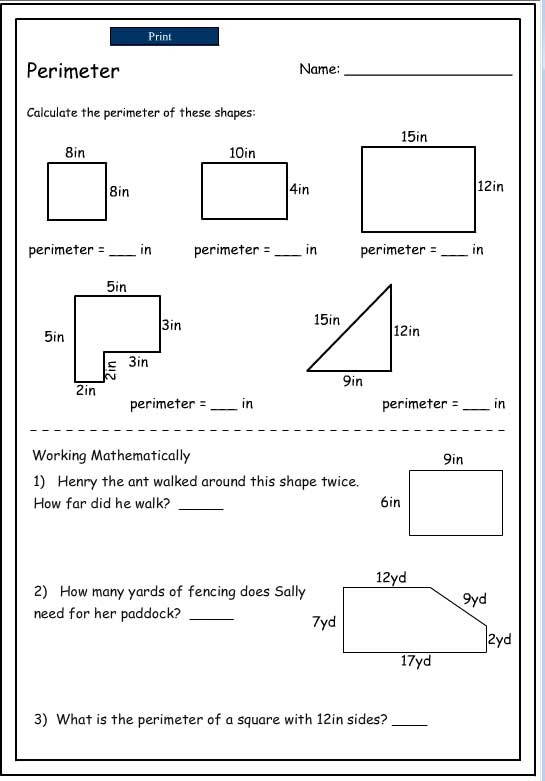
READ MORE:
Introduction to Perimeter
The perimeter of a shape is the total distance around its edges. It is measured in linear units such as meters (m), centimeters (cm), or feet (ft), making it a fundamental concept in geometry and everyday measurements. Understanding how to calculate the perimeter helps in various applications, from construction to design and layout.
Here is a detailed overview of perimeter:
- Definition: The perimeter is the sum of all the sides or boundaries of a shape.
- Units of Measurement: Perimeter is always expressed in units of length.
- Importance: Knowing the perimeter is crucial for tasks involving boundary measurements, material estimates, and layout planning.
Let's delve into how to measure the perimeter for different shapes:
- Basic Shapes
- Rectangle: The perimeter \( P \) of a rectangle with length \( l \) and width \( w \) is given by \( P = 2(l + w) \).
- Square: The perimeter \( P \) of a square with side length \( s \) is given by \( P = 4s \).
- Triangle: The perimeter \( P \) of a triangle with side lengths \( a \), \( b \), and \( c \) is \( P = a + b + c \).
- Circle: The perimeter of a circle, known as the circumference \( C \), with radius \( r \) is \( C = 2\pi r \).
- Complex Shapes: For shapes with irregular boundaries, the perimeter is the sum of all external sides.
To further illustrate, consider these examples:
| Shape | Formula | Example Calculation |
|---|---|---|
| Rectangle | \( P = 2(l + w) \) | For \( l = 8 \, \text{m} \) and \( w = 4 \, \text{m} \), \( P = 2(8 + 4) = 24 \, \text{m} \) |
| Square | \( P = 4s \) | For \( s = 5 \, \text{cm} \), \( P = 4 \times 5 = 20 \, \text{cm} \) |
| Triangle | \( P = a + b + c \) | For \( a = 3 \, \text{m} \), \( b = 4 \, \text{m} \), \( c = 5 \, \text{m} \), \( P = 3 + 4 + 5 = 12 \, \text{m} \) |
| Circle | \( C = 2\pi r \) | For \( r = 7 \, \text{cm} \), \( C = 2\pi \times 7 \approx 43.98 \, \text{cm} \) |
With this understanding of perimeter, you can confidently approach tasks involving the measurement and calculation of boundaries, whether for academic purposes or practical applications.
Basic Concepts of Perimeter
The perimeter is a fundamental geometric concept referring to the total length around a shape. It is a measure of the boundary of two-dimensional figures and is essential in various fields, from mathematics to engineering and design. Here’s a comprehensive look at the basic concepts of perimeter:
- Definition: The perimeter of a shape is the sum of the lengths of all its sides. It provides the total distance around the shape.
- Linear Units: Perimeter is measured in units of length, such as meters (m), centimeters (cm), inches (in), or feet (ft).
- Purpose: Calculating the perimeter helps in determining the required material for fencing, framing, or any application involving the boundary of a shape.
The perimeter varies depending on the shape:
- Rectangles
For a rectangle with length \( l \) and width \( w \), the perimeter \( P \) is calculated as:
\[ P = 2(l + w) \]
This formula adds the lengths of all four sides (two lengths and two widths).
- Squares
For a square with side length \( s \), the perimeter \( P \) is:
\[ P = 4s \]
This is because all four sides of a square are equal in length.
- Triangles
For a triangle with side lengths \( a \), \( b \), and \( c \), the perimeter \( P \) is:
\[ P = a + b + c \]
The perimeter is simply the sum of the lengths of the three sides.
- Circles
For a circle, the perimeter is referred to as the circumference \( C \), and it is calculated using the radius \( r \) as:
\[ C = 2\pi r \]
The circumference measures the distance around the circular boundary.
These fundamental concepts are applied in various practical scenarios, such as determining the length of fencing needed for a garden, the border of a picture frame, or the edge of a fabric piece. Understanding how to measure and calculate perimeter is crucial for both simple and complex geometric shapes.
Units for Measuring Perimeter
Perimeter is the total length around the boundary of a shape, and it is crucial to measure it accurately using appropriate units. The choice of unit depends on the size and context of the measurement. Here’s a detailed overview of the units for measuring perimeter:
- Basic Units of Measurement
Perimeter is typically measured using linear units. These units are standardized and widely used in various fields:
- Meters (m): Commonly used in the metric system, meters are suitable for larger dimensions, such as room perimeters or garden boundaries.
- Centimeters (cm): Centimeters are used for smaller dimensions, like the perimeter of a book or a small object.
- Millimeters (mm): Millimeters are used for very precise measurements, often in technical drawings or manufacturing processes.
- Kilometers (km): Used for extremely large perimeters, such as the boundaries of cities or large geographical areas.
- Inches (in): Commonly used in the imperial system, inches are suitable for medium-scale measurements, such as the perimeter of furniture.
- Feet (ft): Feet are used for larger measurements in the imperial system, like the perimeter of rooms or buildings.
- Yards (yd): Yards are used for even larger distances in the imperial system, such as sports fields or larger plots of land.
- Conversions Between Units
Often, you may need to convert between different units. Here are some common conversions:
- 1 meter (m) = 100 centimeters (cm)
- 1 meter (m) = 1000 millimeters (mm)
- 1 kilometer (km) = 1000 meters (m)
- 1 inch (in) = 2.54 centimeters (cm)
- 1 foot (ft) = 12 inches (in)
- 1 yard (yd) = 3 feet (ft)
Below is a table summarizing the standard units of perimeter measurement:
| Unit | System | Use Case |
|---|---|---|
| Meters (m) | Metric | Room dimensions, garden boundaries |
| Centimeters (cm) | Metric | Smaller objects, books, packages |
| Millimeters (mm) | Metric | Technical drawings, small objects |
| Kilometers (km) | Metric | City boundaries, large areas |
| Inches (in) | Imperial | Furniture, medium-sized objects |
| Feet (ft) | Imperial | Rooms, buildings |
| Yards (yd) | Imperial | Sports fields, large plots |
Understanding these units and their appropriate applications ensures accurate perimeter measurements, essential for both academic purposes and practical applications.
Perimeter Formulas for Different Shapes
Perimeter is measured in units of length. The formula for calculating the perimeter varies depending on the shape. Here are the formulas for some common shapes:
- Rectangle: Perimeter = 2(length + width)
- Square: Perimeter = 4 * side length
- Triangle: Perimeter = sum of the lengths of all three sides
- Circle: Perimeter = 2 * π * radius (or π * diameter)
Each formula encapsulates the necessary steps to calculate the perimeter accurately. For example, to find the perimeter of a rectangle, add together the lengths of all four sides. For a triangle, sum the lengths of its three sides. In a circle, the perimeter is the circumference, calculated using the formula 2πr or πd, where r is the radius and d is the diameter.

Perimeter of Rectangles
The perimeter of a rectangle is the sum of the lengths of all its sides. It is measured in units of length, such as inches, feet, or meters. To find the perimeter of a rectangle, you can use the following formula:
Perimeter = 2(length + width)
This formula accounts for the fact that a rectangle has two pairs of equal-length sides. By adding the lengths of both pairs, you encompass the total distance around the rectangle.
Perimeter of Squares
The perimeter of a square, like that of any other shape, is measured in units of length. It represents the total distance around the square. Since all four sides of a square are equal in length, calculating its perimeter is straightforward.
To find the perimeter of a square, you can use the following formula:
Perimeter = 4 * side length
This formula signifies that to find the perimeter of a square, you simply need to multiply the length of one side by 4, as all sides are of equal length in a square.
Perimeter of Triangles
The perimeter of a triangle, like that of any polygon, is measured in units of length. It represents the total distance around the triangle, encompassing all three sides. Calculating the perimeter of a triangle involves summing the lengths of its three sides.
There isn't a single formula for the perimeter of all triangles, as it depends on the lengths of the sides. However, you can calculate it using the following general approach:
Perimeter = side1 length + side2 length + side3 length
This formula illustrates that to find the perimeter of a triangle, you simply add together the lengths of all three sides.
Perimeter of Circles
The perimeter of a circle, also known as its circumference, is measured in units of length. It represents the distance around the outer edge of the circle. Calculating the perimeter of a circle involves using the circle's radius or diameter.
For a circle, the perimeter formula is:
Perimeter = 2 * π * radius (or π * diameter)
This formula indicates that to find the perimeter of a circle, you multiply either the radius or the diameter by π (pi) and then double the result. The choice between using the radius or diameter depends on the given information.

Perimeter in Real-Life Applications
The concept of perimeter finds numerous applications in real-life scenarios, contributing to various fields such as architecture, construction, engineering, and design. Here are some practical applications of perimeter:
- Construction: Builders and construction workers use perimeter measurements extensively to determine the amount of material required for fencing, landscaping, and laying foundations.
- Architecture: Architects utilize perimeter calculations to design structures, plan building layouts, and allocate space effectively.
- Land Surveying: Surveyors measure perimeters to delineate property boundaries, plot land divisions, and assess land area for development purposes.
- Manufacturing: Perimeter measurements play a crucial role in manufacturing processes, ensuring accurate cutting, shaping, and assembly of materials.
- Urban Planning: City planners utilize perimeter calculations to design roads, sidewalks, parks, and recreational areas, optimizing space utilization and enhancing urban aesthetics.
These are just a few examples showcasing how the concept of perimeter is indispensable in various real-life applications, contributing to the efficiency and functionality of numerous industries and endeavors.
Calculating Perimeter: Step-by-Step Examples
Calculating the perimeter of geometric shapes involves simple yet systematic steps. Here are step-by-step examples illustrating how to calculate perimeter for different shapes:
- Rectangle:
Given a rectangle with length = 5 units and width = 3 units.
Using the formula: Perimeter = 2(length + width)
Substituting the values: Perimeter = 2(5 + 3) = 2(8) = 16 units
Therefore, the perimeter of the rectangle is 16 units.
- Square:
Given a square with side length = 6 units.
Using the formula: Perimeter = 4 * side length
Substituting the value: Perimeter = 4 * 6 = 24 units
Therefore, the perimeter of the square is 24 units.
- Triangle:
Given a triangle with side lengths of 4, 7, and 9 units.
Using the formula: Perimeter = side1 length + side2 length + side3 length
Substituting the values: Perimeter = 4 + 7 + 9 = 20 units
Therefore, the perimeter of the triangle is 20 units.
- Circle:
Given a circle with radius = 8 units.
Using the formula: Perimeter = 2 * π * radius
Substituting the value: Perimeter = 2 * π * 8 = 16π units (approximately 50.27 units)
Therefore, the perimeter of the circle is approximately 50.27 units.
Visualizing Perimeter: Diagrams and Illustrations
Visual aids such as diagrams and illustrations are invaluable tools for understanding the concept of perimeter. They provide clear visual representations of geometric shapes and their respective perimeters, aiding in comprehension and retention. Below are some examples of how diagrams and illustrations can help visualize perimeter:
- Rectangles: Diagrams can depict the length and width of rectangles, along with labels indicating the measurements. Arrows can illustrate the path around the perimeter, emphasizing the concept of perimeter as the total distance around the shape.
- Squares: Similarly, squares can be visually represented with all four sides labeled with their lengths. Arrows or dotted lines can highlight the perimeter, demonstrating that it encompasses the length of all four sides.
- Triangles: Diagrams of triangles can display the lengths of each side, as well as the angles. Visual cues such as dashed lines or color-coding can indicate the path around the triangle, emphasizing the perimeter.
- Circles: Illustrations of circles can showcase the radius or diameter, as well as the circumference (perimeter). Using a compass or circular object as a visual aid, students can see how the perimeter represents the distance around the circle.
By incorporating diagrams and illustrations into educational materials, educators can enhance students' understanding of perimeter, making abstract concepts more tangible and engaging.
Common Mistakes in Measuring Perimeter
While calculating perimeter is a relatively straightforward process, certain common mistakes can lead to inaccuracies. It's essential to be aware of these errors to ensure accurate measurements. Here are some common mistakes in measuring perimeter:
- Incorrect Measurement Units: Using inconsistent units or forgetting to convert measurements can result in erroneous perimeter calculations. It's crucial to ensure all measurements are in the same units before calculating perimeter.
- Missing Sides: Forgetting to include all sides of a shape when calculating perimeter can lead to an incomplete measurement. Each side contributes to the total distance around the shape, so it's essential to include them all.
- Double Counting: In some cases, individuals may accidentally count certain sides twice when calculating perimeter. This can occur when a side is shared between multiple shapes or when counting both the length and width of rectangles, for example.
- Ignoring Curved Edges: When measuring the perimeter of shapes with curved edges, such as circles, it's important to include the entire circumference. Ignoring curved edges or measuring them incorrectly can lead to significant inaccuracies.
- Assuming Equal Sides: While squares have four equal-length sides, not all shapes have this property. Assuming that all sides are equal without verifying can result in incorrect perimeter calculations for shapes like rectangles, triangles, and irregular polygons.
By being mindful of these common mistakes and double-checking calculations, individuals can ensure accurate measurements of perimeter, leading to more reliable results in various applications.

Advanced Topics: Perimeter in Complex Shapes
Measuring the perimeter of complex shapes presents unique challenges due to their irregular or non-standardized geometries. Advanced topics in perimeter calculation involve strategies for determining perimeter in such complex shapes. Here are some key considerations:
- Breakdown into Simple Shapes: Complex shapes can often be broken down into simpler components, such as rectangles, triangles, circles, or semicircles. By calculating the perimeter of each component and summing them, you can find the total perimeter of the complex shape.
- Approximation Methods: In cases where precise measurements are challenging, approximation methods may be employed. This involves estimating the perimeter using known formulas and geometric principles, taking into account the irregularities of the shape.
- Composite Figures: Complex shapes may comprise multiple simpler shapes combined together. Calculating the perimeter of composite figures involves identifying and measuring the perimeters of each component shape, considering any overlaps or intersections.
- Integration of Technology: Advanced tools such as computer software, CAD (Computer-Aided Design) programs, or specialized calculators can aid in calculating the perimeter of complex shapes accurately. These tools utilize algorithms and mathematical models to handle intricate geometries effectively.
- Real-Life Applications: Understanding perimeter in complex shapes is essential in various fields, including architecture, engineering, landscaping, and urban planning. Professionals in these fields often encounter irregular geometries and rely on advanced perimeter calculation techniques to design and construct efficiently.
By mastering advanced topics in perimeter calculation, individuals can tackle the complexities of irregular shapes and apply their knowledge effectively in real-world scenarios.
Frequently Asked Questions About Perimeter
Perimeter is measured in various units depending on the system of measurement used. In the metric system, the most common unit for measuring perimeter is meters (m). In the imperial system, perimeter can be measured in feet (ft) or yards (yd). Additionally, other units such as centimeters (cm) or kilometers (km) may also be used.
Conclusion: Importance of Perimeter
The concept of perimeter is crucial in various fields such as mathematics, engineering, architecture, and construction. Understanding perimeter allows us to calculate the boundary length of shapes accurately, which is essential for designing buildings, creating blueprints, constructing roads, and more.
By knowing how to measure perimeter and apply it in real-world scenarios, individuals can efficiently plan and execute projects, ensuring that structures are properly dimensioned and meet safety standards.
Moreover, mastering perimeter helps develop problem-solving skills and enhances spatial awareness, which are valuable assets in both academic and professional settings.
Học cách tính chu vi của các đa giác qua video dành cho trẻ em từ FreeSchool.
Giới Thiệu về Chu Vi cho Trẻ Em: Cách Tìm Chu Vi của Đa Giác - FreeSchool
READ MORE:
Video hướng dẫn cách tìm chu vi một cách dễ hiểu và thu hút người xem. Hãy cùng khám phá!
Tìm Chu Vi



